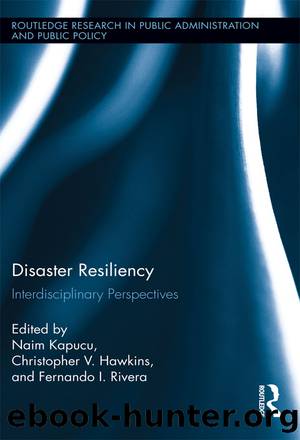Disaster Resiliency by Kapucu Naim;Hawkins Christopher V.;Rivera Fernando I.;

Author:Kapucu, Naim;Hawkins, Christopher V.;Rivera, Fernando I.;
Language: eng
Format: epub
Publisher: Taylor & Francis Group
11 Incorporating Resilience of Rural Communities for Proactive Risk Reduction in Shikoku, Japan
Rajib Shaw
INTRODUCTION
Japan is located on the eastern edge of the monsoon region of Asia and its climate varies according to the seasonal and regional conditions. Typically, heavy rains occur in various parts of the country both during the rainy season in June and July and during the typhoon season from August to October. This precipitation is predominantly in the form of locally specific temporary downpours. In winter, the northern part of the country usually receives heavy snowfall, which causes prolonged floods in spring caused by the melting of snow.
Owing to these meteorological characteristics, flood disasters caused by heavy rains occur frequently in Japan. Topographically, about 70% of the land is mountainous and covered with forests. Additionally, rivers in Japan are generally very short and steep, causing flash flooding with high concentrated peak discharges soon after an intense rainfall. The remaining 30% of the land is mostly alluvial plains where housing, farming, and industries are densely concentrated, consequently increasing the vulnerability to flood disasters.
In addition to these climate challenges, the aging society is a major issue in Japan, especially for rural communities. The population of elderly people compromises 23% of the total population in the country (Statistics Bureau, 2008). The national government expects this to rise to 30% by 2025 (Shaw & Takeuchi, 2011). Recognizing these trends the Japanese government has declared that people over sixty-five years old are easily affected by disasters. An older population has implications for disaster resiliency. For example, housing for elderly tends to be relatively large and requires large parcels of land for new construction. Hence, it is often the case that facilities for the elderly are located on hills and in the mountains where land is relatively cheaper, but which are prone to landslides.
At the same time, the elderly population in Japan has shown significant levels of resilience due to higher social capital and community linkages during times of disasters. Thus the opportunities and challenges for policy makers are to utilize the social resilience of rural communities during normal times to prepare for disaster response and recovery. This chapter underlines the community resilience in rural communities in Japan while exemplifying the disaster risks and community-based risk reduction activities in three contrasting communities on Shikoku Island.
Download
This site does not store any files on its server. We only index and link to content provided by other sites. Please contact the content providers to delete copyright contents if any and email us, we'll remove relevant links or contents immediately.
Man-made Catastrophes and Risk Information Concealment by Dmitry Chernov & Didier Sornette(4748)
The Revenge of Geography: What the Map Tells Us About Coming Conflicts and the Battle Against Fate by Kaplan Robert D(3602)
Zero Waste Home by Bea Johnson(3297)
COSMOS by Carl Sagan(2959)
In a Sunburned Country by Bill Bryson(2953)
Good by S. Walden(2920)
The Fate of Rome: Climate, Disease, and the End of an Empire (The Princeton History of the Ancient World) by Kyle Harper(2442)
Camino Island by John Grisham(2391)
A Wilder Time by William E. Glassley(2367)
Organic Mushroom Farming and Mycoremediation by Tradd Cotter(2314)
Human Dynamics Research in Smart and Connected Communities by Shih-Lung Shaw & Daniel Sui(2181)
The Ogre by Doug Scott(2120)
Energy Myths and Realities by Vaclav Smil(2066)
The Traveler's Gift by Andy Andrews(2017)
Inside the Middle East by Avi Melamed(1946)
Birds of New Guinea by Pratt Thane K.; Beehler Bruce M.; Anderton John C(1915)
Ultimate Navigation Manual by Lyle Brotherton(1770)
A History of Warfare by John Keegan(1722)
And the Band Played On by Randy Shilts(1620)
